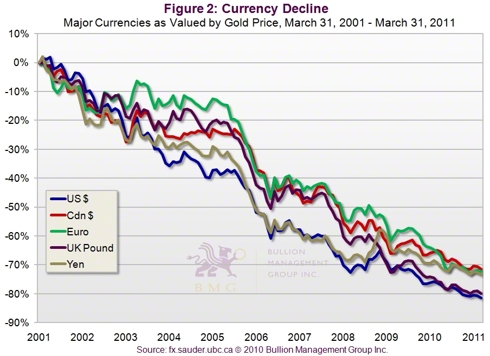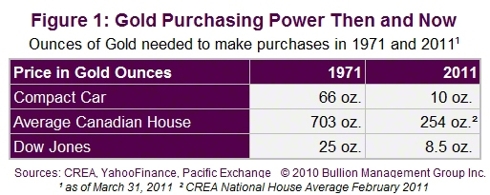The Truth About ‘Investing’ in Gold
To fully understand gold’s role in an investment portfolio, we need to adopt a new mindset, a gold mindset which is, simply put: gold is not a bad investment, and gold is not a good investment. Gold is not an investment at all – gold is money
. [Let me explain.] Words: 816
So says Nick Barisheff (www.bmgbullion.com) in an article* which Lorimer Wilson, editor of www.munKNEE.com , has further edited ([ ]), abridged (…) and reformatted below for the sake of clarity and brevity to ensure a fast and easy read. Please note that this paragraph must be included in any article re-posting to avoid copyright infringement. Barisheff goes on to say:
While many people believe gold is an archaic relic that has no role in today’s sophisticated, computerized, paper-based monetary system, three facts contradict this popular misconception:
- Gold, silver and platinum are traded on the currency desks of the major banks and brokerage houses, not the commodity desks. Traders understand gold is money to be traded against paper currencies.
- The world’s central banks hold about 30,000 tonnes of gold in reserves. While there has been a lot of media attention given to central bank sales in the past, gold holdings have only declined by about 2,000 tonnes since 1980. Central banks have become net buyers since 2009 and have been adding gold to their currency reserves. Central bankers understand gold is money.
- The turnover rate between members of the London Bullion Market Association is over US$20 billion per day, with volume estimated at five to seven times that amount. Clearly, this has nothing to do with jewelry sales and everything to do with the exchange of money.
The Difference Between Owning an Investment and Owning Gold
The definition of “investment” is the commitment of money or capital to purchase financial instruments or other assets in order to gain profitable returns in the form of interest, income or appreciation of the value of the investment. Through this transfer of capital, in the expectation of a profit, an investor gives up capital and puts it at risk. The investor receives a return in dividends or interest as compensation because capital is at risk; investors may get back less than they invested, or they may get back nothing at all.
Sign up for FREE weekly “Top 100 Stock Index, Asset Ratio & Economic Indicator Trends” report
Physical gold bullion or physical paper currencies locked in a vault, on the other hand, are not invested; they are simply being stored. Since neither is invested, they don’t earn interest or dividends – but they don’t have any counterparty risk. The major difference between gold and currencies kept in a vault, however, is that gold’s purchasing power increases while paper currencies lose purchasing power year after year.
Both gold and currencies can be taken out of the vault with ease, and the proceeds invested by giving them to someone else in return for dividends or interest. An interesting perspective can be gained by calculating whether the proposed investment is likely to return more gold ounces than were originally invested. For example, the 44 ounces of gold required to purchase the Dow in 2000 has now dwindled to fewer than nine ounces. [You] might as well have left the gold in the vault! Since gold maintains and even increases in purchasing power, there is no need to put it at risk in order to earn a minimal amount of interest or dividends.
Gold’s Purchasing Power Over the Years
Figure 1 illustrates how gold has not only preserved but also increased its purchasing power from 1971, when the gold standard was abandoned, to 2011.
Gold’s Value Compared to Major Currencies
Figure 2 illustrates how all of the major currencies have declined over the last decade when measured by gold ounces.

Conclusion
It is crucial to recognize that physical gold bullion, held directly or on an allocated and insured basis in a vault, is not an investment because it is not someone else’s promise of performance or someone else’s liability, and as a result has no counterparty risk. All other forms of gold ownership are, in fact, investments. Paper gold certificates, unallocated bullion accounts, ETFs, shares in gold mining companies and futures contracts all have counterparty risk, and are either someone else’s promise of performance or liability. They may have their place in a portfolio, but they are all investments.
We hold physical gold in a vault, we hold physical currencies in a bank, but we invest in financial assets. [Check us out at the web sit below.]
*http://www.bmgbullion.com/lib.pl
Editor’s Note:
- The above article consists of reformatted edited excerpts from the original for the sake of brevity, clarity and to ensure a fast and easy read. The author’s views and conclusions are unaltered.
- Permission to reprint in whole or in part is gladly granted, provided full credit is given as per paragraph 2 above.
- Sign up to receive every article posted via Twitter, Facebook, RSS Feed or our FREE Weekly Newsletter.
Gold
 munKNEE.com Your Key to Making Money
munKNEE.com Your Key to Making Money
